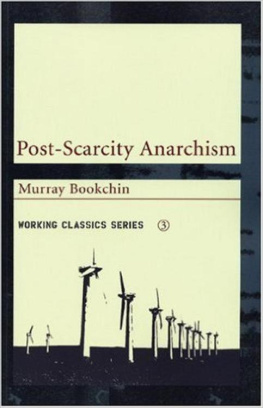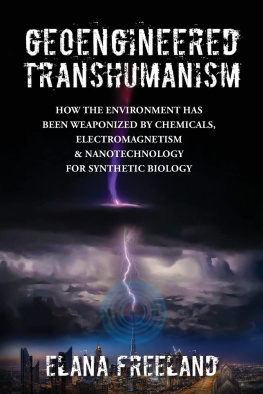Our Synthetic Environment
by
Murray Bookchin
1962

All Your Books Are Belong To Us !
http://c3jemx2ube5v5zpg.onion
Our Synthetic Environment
Copyright 1962 Murray Bookchin
"Our Synthetic Environment" covered not only the whole range of issues concerning pesticide and herbicide contamination of the environment, but went much further by exposing the health and environmental hazards caused by the spread of unproven medicines; the burgeoning market in untested food additives, dangerous food processing and packaging; chemically fertilized crops and the damage done to soil fertility and plants alike; air, water, land pollution; noise pollution, the health hazards of our stress-out highly mechanized life-styles; population pressures, etc., ad infinitum, ad nauseum.
Bookchin summarizes our high-tech, synthetic society as becoming "anti-ecological" and far out of balance with the needs of Nature to provide a healthy, sustainable existence for all life. He proffers the collusion of government and profit driven corporations to deregulate health and safety standards is trashing our democracy. Yet he contends that one of the most damaging side-effects of our "growth" mania driven society is global warming. How many people were thinking about that in 1962?
Contents
Chapter One: The Problem
Our Changed Environment
Life in the United States has changed so radically over the past one hundred years that the most wearisome historians tend to become rhapsodic when they describe the new advances that have been made in technology, science, and medicine. We are usually told that early in the last century most Americans lived heroic but narrow lives, eking out a material existence that was insecure and controlled by seasonal changes, drought, and the natural fertility of the soil. Daily work chores were extremely arduous; knowledge, beleaguered by superstition, was relatively crude. Historians with an interest in science often point out that medical remedies were primitive, if not useless; they may have sufficed to relieve the symptoms of common diseases, but they seldom effected a cure. Life was hard and precarious, afflicted by many tragedies that can easily be avoided today.
In contrast with the men of the last century, men today, we are told, have developed nearly complete control over the natural forces that once were the masters of their ancestors. Advances in communication have brought knowledge and safety to the most isolated communities. The most arduous work has now been taken over by machines, and material existence has become secure, even affluent. Common illnesses that once claimed the lives of millions are now easily controlled by a scientific knowledge of disease, effective drugs, new diagnostic devices, and highly developed surgical techniques. The American people, it is claimed, enjoy more leisure, better health, greater longevity, and more varied and abundant diets than did their forebears a hundred years ago.
On the face of it, these statements are true, but by no means are all the advances as beneficial as the historians would have us believe. Recent changes in our synthetic environment have created new problems that are as numerous as those which burdened the men of the past. For example, soon nearly 70 per cent of the American population will be living in large metropolitan centers, such as New York, Chicago, and Los Angeles. They will be exposed in ever-greater numbers to automobile exhausts and urban air pollutants. Perhaps an even larger percentage of the employed population will be working in factories and offices. These people will be deprived of sunlight and fresh air during the best hours of the day. Factory and office work, while less arduous than in the past, is becoming more intensive. Although the working day early in the last century was very long, the worker worked comparatively slowly, and both the employer and employee gave relatively little thought to productivity. Today, employers require a greater output per hour from each worker. The use of machines tends to make work monotonous and sedentary, often exhausting human nerves as completely as manual work exhausted human muscles. Modern man is far less physically active than his forebears were. He observes rather than performs, and uses less and less of his body at work and play. His diet, although more abundant, consists of highly processed foods. These foods contain a disconcertingly large amount of pesticide residues, coloring and flavoring matter, preservatives, and chemical technological aids, many of which may impair his health. His waterways and the air he breathes contain not only the toxic wastes of the more familiar industries but radioactive pollutants, the byproducts of peacetime uses of nuclear energy and nuclear weapons tests.
With the rise of these problems, dramatic changes have occurred in the incidence of disease. In 1900, infectious diseases, such as pneumonia, influenza, and tuberculosis, were the principal causes of death. Death from heart disease and cancer occupied a secondary place in American vital statistics. Fifty years later, mortality rates from infectious diseases had declined to a fraction of what they had been, but the percentage of deaths from heart disease and malignant tumors had more than doubled. It is very difficult to obtain reliable comparative statistics on the incidence of chronic, or persistent, diseases, but we can regard it as almost certain that the proportion of chronically ill individuals in the American population has increased. In any case, millions of Americans today suffer from major chronic disorders. Nearly 5 million people are afflicted with heart disease; another 5 million have high blood pressure. More than 12 million suffer from arthritis, 4 million from asthma, and at least 700,000 from cancer. Additional millions suffer from diabetes, kidney disease, and disorders of the nervous system.
Because many of these illnesses claim the lives of elderly people, we tend to associate chronic diseases with the aging process, and we usually explain their widespread occurrence by the fact that people are living longer. Men must die of something. With a reduction in the number of deaths from tuberculosis, influenza, and childhood infections, the diseases of aging people, it is claimed, should be expected to dominate our vital statistics. But are these diseases strictly products of the aging process? Do we have any evidence that they arise from basic physical disturbances peculiar to senescence? The answer is almost certainly no. Many disorders which afflict young people are precisely those so-called degenerative diseases that physicians and laymen associate with the retrogressive physical changes of old age.
Consider the age distribution in the incidence of cancer. Although many types of cancer are found mostly after the fourth or fifth decade of life, a surprisingly large number of varieties occur most frequently in childhood, youth, and early maturity. Cancers of the kidney and the adrenal glands usually appear before the age of four. Bone cancers reach their highest incidence in the ten-to-twenty-four age group. Malignant tumors of the testes usually occur in infancy and at maturity. So deeply entrenched was the notion that malignant tumors are diseases of elderly people that for many years physicians often discounted early symptoms of certain cancers in children. We now know that cancer in children occurs in nearly all the major physical organs of the body.
Today, cancer is second only to accidents as a leading cause of death in American children over one year of age. Although mortality rates for childhood cancers fluctuate from year to year, they have moved in a decidedly upward direction over the past two decades; for American children under fifteen years of age, they rose 28 per cent between 1940 and Igss. In 1959, cancer claimed 4100 lives and accounted for 12 per cent of all deaths in children between the ages of one and fourteen. These statistics make it hazardous to say that the illness is essentially part of the aging process. Strong reasons exist for suspecting that environmental factors contribute significantly to increases in death from cancer among young people.










